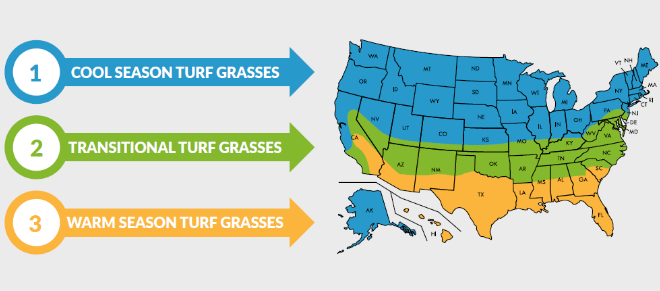- Categories:

Early spring is a great time to seed your turf to have it green and healthy for summer. But what type of grass is the right choice for your application? Here are some guidelines to make sure you are planting the right varietal to ensure success.
Grasses by Region
Turf grass is divided into two types – cool season (grasses normally grown in colder climates) and warm season (grasses found in warmer areas). While both types can be planted anywhere, selecting native grasses will increase your chances for a lush, green lawn.
Cool Season Grasses
Normally found in the Upper South, Midwest and Northern areas, these grasses do best where temperatures are between 65° and 70° for much of the growing season. These grasses will go dormant when it is too warm (over 90°F) or too cold (under to 32°F). The key is to plant when soil temperatures are around 55°, or when daytime air temperatures are consistently between 60° and 70°.
Warm Season Grasses
Warm season grasses are found in Southern states, into Transition Zone areas of the Great Plains & Mid-Atlantic, where temperatures are between 85° and 90° for much of the growing season. It will go dormant when temperatures drop to 64° and below, and soil temperatures below 55° can cause damage. Late spring and early summer are the ideal time for planting to see faster germination and rapid establishment. It’s best to plant when soil temperatures are 70+° F, or when daytime air temperatures are above 80° and nighttime air temperatures are 65° to 70°.
So, what grass is best for your application?
|
Cool Season |
Tall Fescue |
Very low maintenance grass. Superior heat and drought tolerance. NOTE: “Dwarf” fescue is simply a description used for today’s improved Tall Fescue varieties, “Tall Fescue” is the species – it does not mean “tall.” |
Ideal for transition zone, specifically for residential lawns. Lush and green |
|---|---|---|---|
|
Cool Season |
Kentucky Bluegrass |
Deep and crawling roots produce a strong turf |
Common in seed mixes intended for high traffic areas and sports fields. |
|
Cool Season |
Fine Fescue (Chewings, Creeping Red) |
Have fine leaves, high shade tolerance |
Ideal in shade areas. Also frequently chosen for low-or-no-mow native areas. |
|
Cool Season |
Perennial Ryegrass |
Fast germination, soft texture |
Common in mixes. Most frequently used to overseed warm season bermudagrass. NOTE: Do not mistake “annual ryegrass” to be the same – Annual is much less aesthetically pleasing, grows spindly and unevenly compared to Perennial. Fine for roadsides, but not good in mixes intended for well-kept lawns. |
|
Cool Season |
Bentgrass |
High maintenance, tolerates very low mowing heights |
Rarely used in lawns, but is the primary grass for golf course greens. |
|
Warm Season |
Bermudagrass |
Aggressive, resilient, known for its heat and drought tolerance. |
The go-to grass for lawns across the southern states. Requires full sun and good drainage. |
|
Warm Season |
St. Augustine Grass |
Lush green grass that is heat tolerant and moderately drought tolerant. Most common in Florida, gulf areas and So. California. |
Grows in full sun, but also shade tolerant. Not ideal for high traffic areas. Requires frequent mowing. Available in sprig or sod only |
|
Warm Season |
Buffalograss |
Most drought tolerant of all warm season, as it is truly native to N. America. Fine in texture, resulting in a thinner turf. |
Not for shade or high traffic areas. Ideal for road sides, open lawn areas and golf roughs. |
|
Warm Season |
Zoysiagrass |
More lush & beautiful than most warm season grasses. High maintenance and temperamental. |
Establishes slowly, but results in dense turf. Best in full sun. Should be aerated & dethatched every year. |
|
Warm Season |
Bahiagrass |
Aggressive and drought tolerant |
Ideal for erosion control and along roadsides |
Proper Care of a New or Established Lawn
Use a starter fertilizer at time of planting. Applying a product containing a high proportion of Phosphorus (middle number) improves germination and establishment.
Regular & properly timed feedings of Slow Release fertilizer will maintain the health of the lawn.
- Cool Season Grasses – Apply fertilizer primarily in fall and spring; AVOID fertilizing in the peak of summer (above 90°).
- Warm Season Grasses – Apply fertilizer from late spring through summer; AVOID fertilizing too late in the fall, when grass needs to harden off to tolerate the winter. NOTE: If overseeding the permanent warm season stand with Perennial Ryegrass, avoid fertilizing during the transition periods (prior to overseed in the fall, and as temperatures rise in the spring to trigger warm season grass out of dormancy), to reduce competition of the two types of grass.
Not sure what fertilizer to apply when? Follow the TurfGro fertilizer program, designed to meet the lawn & landscape needs of your region.
Get your seed today!

Horizon is a proud distributor of Top Choice Seed. Top Choice seed is 99.9% weed free and only contains varieties that are selected for your region. Blends & mixes include:
- Landscaper Mix
- Sun & Shade
- Fescue Blend
- Perennial Rye Blend
- Shady
- Playground
- Bermuda
Top Choice is available in 3, 10 and 20 pound bags. Find your local Horizon store here.